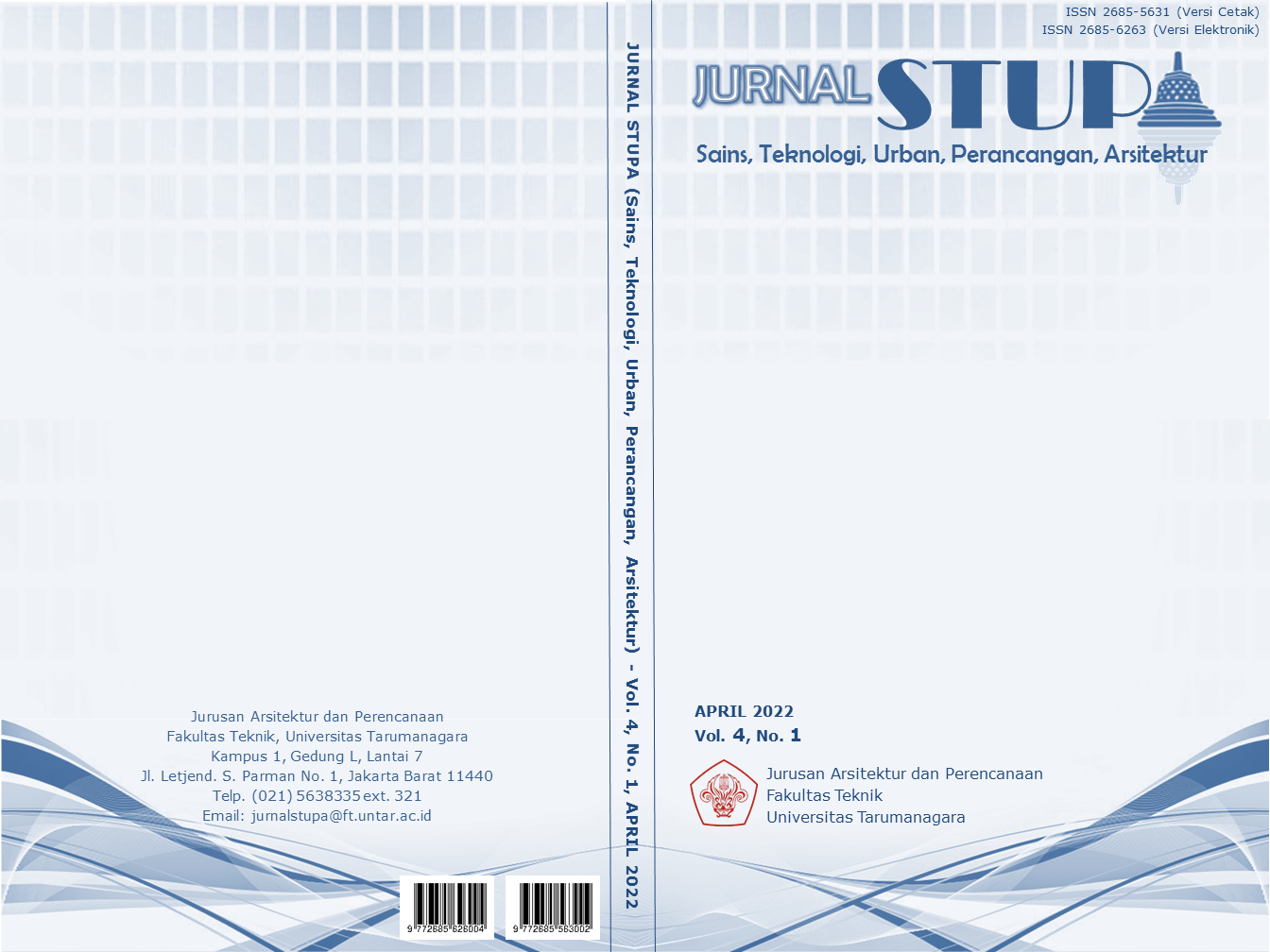PENERAPAN KONSEP RE-THINKING TYPOLOGY PADA HUNIAN VERTIKAL UNTUK DEWASA MUDA DI LAHAN BERKONTUR, CISARUA
Isi Artikel Utama
Abstrak
This paper describes and analyzes the types or characteristics of typologies as well as proposes a different typological idea for the typology of vertical housing located in contoured and heavily cultured areas for evolving young adults. This provides views and insights into the architectural thought process. Based on learning the existing type as a reference and choosing various typology as prototype and as a reference for analysing the development trend of vertical housing typology as a guide principle to then propose an arhetype. The results of these analysis are proven re-thinking the typology of the vertical housing itself which is integrated with the microhousing typoloogy. Two typologies emerged, providing insight into the aplication of cultural cosmologi and also integrating the contoured site with the project.
Keywords: contour; microhousing; typology; vertical housing
Abstrak
Tulisan ini menjelaskan dan menganalisis tipe atau karakteristik tipologi serta mengusulkan sebuah pemikiran tipologi yang berbeda terharap tipologi bangunan vertikal yang berada di daerah berkontur dan berbudaya untuk kaum dewasa muda yang sedang berkembang. Makalah ini memberikan pandangan dan wawasan ke dalam proses pemikiran arsitektur. Berdasarkan pembelajaran tipe eksisting sebagai acuan tren perkembangan dan tipologi bangunan hunian vertikal sebagai panduan prinsip, pendekatan pemikiran ulang tipologi untuk menganalisa tipologi yang ada muncul suatu tipologi baru. Hasil dari analisis ini dibuktikan dengan memikirkan ulang tipologi bangunan vertikal itu sendiri yang di integrasikan dengan tipologi rumah mikro. Dua tipologi yang muncul, memberikan wawasan tentang penerapan kosmologi budaya dan juga mengintegrasikan tapak yang berkontur dengan proyek.
Rincian Artikel
Referensi
Agarwal, S., Guntuku, S. C., Robinson, O. C., Dunn, A., & Ungar, L. H. (2020). Examining the Phenomenon of Quarter-Life Crisis Through Artificial Intelligence and the Language of Twitter. Frontiers in Psychology, 11(341).
Budiarti, R. M. (2021, May 17). RSJ Menur. Retrieved from http://rsjmenur.jatimprov.go.id/: http://rsjmenur.jatimprov.go.id/post/2021-05-17/fenomena-quarter-life-crisis
CLARK, R. H., & PAUSE, M. (1996). Precedents in Architecture. New York: Van Nostrand Reinhold.
Foye, C. (2017). The Relationship Between Size of Living Space and Subjective Well-Being. Journal of Happiness Studies, 18(2), 427-461.
Kholid, M. F., & Zaharin, P. M. B. (2019). Micro Housing: Typological study and implementation in Malaysia. Environment-Behaviour Proceedings Journal, 4(12), 265-278.
KLAM, A. (1982). Space and Material: Towards an Architectural Typology. Paris: M.I.T.
MONEO, R. (1978). "On Typology". Oppositions 13, 23-45.
Robinson, O. C., Wright, G. R. T., & Smith, J. A. (2013). The Holistic Phase Model of Early Adult Crisis. Journal of Adult Development, 20(1), 27-37.
SUSANTO, A. (2020). Peta Metode Desain. Jakarta: Universitas Tarumanagara.
Shearer, H., & Burton, P. (2019). Towards a Typology of Tiny Houses. Housing, Theory and Society, 36(3), 298-318.
Schroeder, J. (2016, September 8). Forbes. Retrieved from www.forbes.com: https://www.forbes.com/sites/julesschroeder/2016/09/08/millennials-this-is-what-your-quarter-life-crisis-is-telling-you/?sh=4f95bcca3262
Utomo, W. P., & Noormega, R. (2019, June). IDN Research Institute. Retrieved from https://research.idntimes.com/: https://cdn.idntimes.com/content-documents/Indonesia-millennial-report-2020-by-IDN-Research-Institute.pdf



